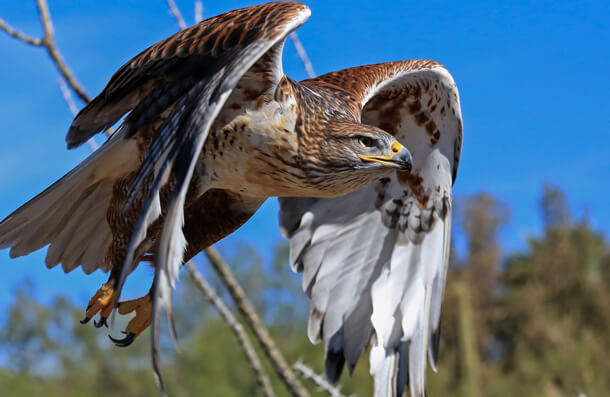Obama Administration Considering New Options for Conserving Migratory Birds

Ferruginous Hawk, Thomas Barrat, Shutterstock
(Washington, D.C., May 22, 2015) The U.S. Fish and Wildlife Service will announce Tuesday that it intends to prepare a programmatic environmental impact statement to evaluate the effects of authorizing incidental take of migratory birds under the Migratory Bird Treaty Act (MBTA). American Bird Conservancy, which petitioned the administration in 2011 and again in 2015 to adopt a permitting system to reduce or eliminate incidental bird mortality caused by wind energy developments, applauds this action.
“Bird lovers across America will now be able to submit comments in support of protecting the migratory birds that enliven their spring and fall seasons,” said Steve Holmer of American Bird Conservancy. “There have been great advances in our knowledge for conserving birds, and this process can put that knowledge to work and turn best management practices into standard practices.”
The Notice of Intent offers a menu of potential options including issuing permits to industries that impact birds via structures such as wind turbines, communications towers, and powerlines. In each example included in the notice, there are already available technologies that can reduce bird mortality.
“This rule can help migratory birds better survive the multiple threats they face each year,” said Holmer. “We have technologies to help prevent birds from falling into oil pits, colliding with communications towers, or being electrocuted by powerlines; this rule can make sure these already-available solutions are used.”
The ABC petition filed in February this year called for wind industry regulatory action that would reduce the projected 1.4 to2 million bird deaths expected to be caused by the industry when it reaches projected buildout levels. A key provision of the ABC petition urged the Department of Interior's Fish and Wildlife Service (FWS) to establish a permitting process that would significantly improve the protection of birds covered by the MBTA and would afford the wind industry a degree of regulatory and legal certainty that cannot be provided in the absence of such a process.
The wind industry is now operating under “voluntary” instead of mandatory regulatory guidelines. These optional operating sideboards have paved the way for widespread disregard of the legal mandates the FWS is entrusted to enforce. If not done right, wind energy poses a serious threat to various species of birds, including birds of prey such as the Bald Eagle, Golden Eagle, Ferruginous Hawk, Swainson's Hawk, Short-eared Owl, and Flammulated Owl; endangered and threatened species such as the California Condor, Kirtland's Warbler, Whooping Crane, Snail Kite, Marbled Murrelet, Hawaiian Goose, and Hawaiian Petrel; and other species of special conservation concern such as the Bicknell's Thrush, Sprague's Pipit, Cerulean Warbler, Long-billed Curlew, Bay-breasted Warbler, and Blue-winged Warbler.
“These species are impacted by existing wind energy projects and threatened by potential projects primarily through collisions with wind turbines and associated powerlines and towers, and through loss or modification of essential habitat,” said Mike Parr, ABC's Chief Conservation Officer.
The MBTA, Endangered Species Act (ESA), and the Bald and Golden Eagle Protection Act (BGEPA), prohibit “take” of migratory birds, endangered and threatened species, and Bald and Golden Eagles.
While the ESA and BGEPA provide mechanisms for FWS to regulate, and in some instances authorize, take of endangered and threatened species and Bald and Golden Eagles respectively, at present no such comparable mechanism exists under the MBTA to limit or authorize incidental take by wind power projects or other industries.
ABC recently sounded another note of alarm concerning avian mortality when it announced the findings of a just-completed, ABC-funded study that documented that wind turbines are being installed in sensitive bird habitat on a massive scale. More than 30,000 wind turbines have been installed in areas critical to the survival of federally-protected birds in the United States and more than 50,000 additional turbines are planned for construction in similar areas. Endangered Whooping Cranes will face a gauntlet of 24,000 turbines along their migration route.


















































